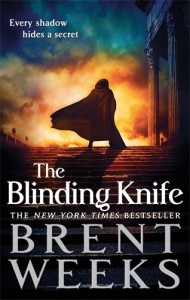The Best Possible Betrayal, or The Fine Art of the Plot Twist in Your Back
 I love a great plot twist. After writing and publishing six big fantasy novels, I’ve become pretty hard to fool with a twist, but every time I hear a reader say, “I never saw that coming, but looking back, it made so much sense.” I get to feel the pleasure anew. It is, of course, merely a vicarious pleasure, but living vicariously is kind of what novelists do.
I love a great plot twist. After writing and publishing six big fantasy novels, I’ve become pretty hard to fool with a twist, but every time I hear a reader say, “I never saw that coming, but looking back, it made so much sense.” I get to feel the pleasure anew. It is, of course, merely a vicarious pleasure, but living vicariously is kind of what novelists do.
The Lightbringer Series is, in part, an ass-kicking examination of identity and integrity. Many of the characters have secrets that influence both, and these secrets are revealed not through navel gazing and discourse, but through actions, lies, and inadvertent truths that escape when the characters are under great pressure. Characters do what they don’t say, say what they don’t think, and think what they don’t do. All of which is fertile ground for surprises.
But a plot twist is more than just a character acting in a way that surprises us. A chaotic or insane character does that. (And, let’s be honest, an actually chaotic character might be impossible to pull off. The most famous recent example of a wildly chaotic character is, if one thinks about it at all, actually a master planner par excellence: Heath Ledger’s Joker from The Dark Knight.) Instead, a great plot twist takes a lot of planning and careful management of what a reader thinks is going on at any moment.
But how do you manage audience expectations when an audience ranges from teens reading the very first book they’ve ever read outside of assigned reading to adults who have been reading fantasy for fifty years? Movies get to cheat on this. If you have a convoluted plot, and something’s always happening on screen, only a tiny percentage of people will be able to think through the plot holes and possible lacunae in the two hours they’re watching. With a big fantasy novel, authors don’t have that luxury. Some readers devour, and other readers savor, thinking through every tidbit, and guessing for weeks where the plot’s going.
In THE BLINDING KNIFE (US | UK | AUS), I’ve addressed the challenge by layering the plot twists. Some are relatively simple to see coming, some are challenging, and some challenge you in thinking you knew exactly where this series was headed.
And for the future, I have planned a finer subtlety still: the plot twist none of the characters realize, and never find out. I can’t wait until you see it! Or, ya know, for most of you, don’t.
That penultimate one is risky (taking the plot where readers didn’t expect at all), because if you push too far, some readers simply opt out. If they were certain that this series was going to be about Kip becoming the Lightbringer, and I substitute that Zymun is actually the guy (bummer), they may stop following me, even if two twists from now, I was going to give them Kip again, even better than before. So how much trust can I ask? How wildly can I diverge from genre expectations without losing too many of you? My answer is different now than it was when Night Angel hit the stands. In six books, I hope that I’ve earned the latitude to say, “Trust me, that sharp pain in your back isn’t a knife, it’s a Swedish massage. I know what I’m doing, and I would never, ever betray your faith in me.”
Ironfist dies on page 407.
…
Books one and two of the Lightbringer Series, THE BLACK PRISM (US | UK | AUS) and THE BLINDING KNIFE (US | UK | AUS), are now available in trade paperback! Look for them online and in stores everywhere.
